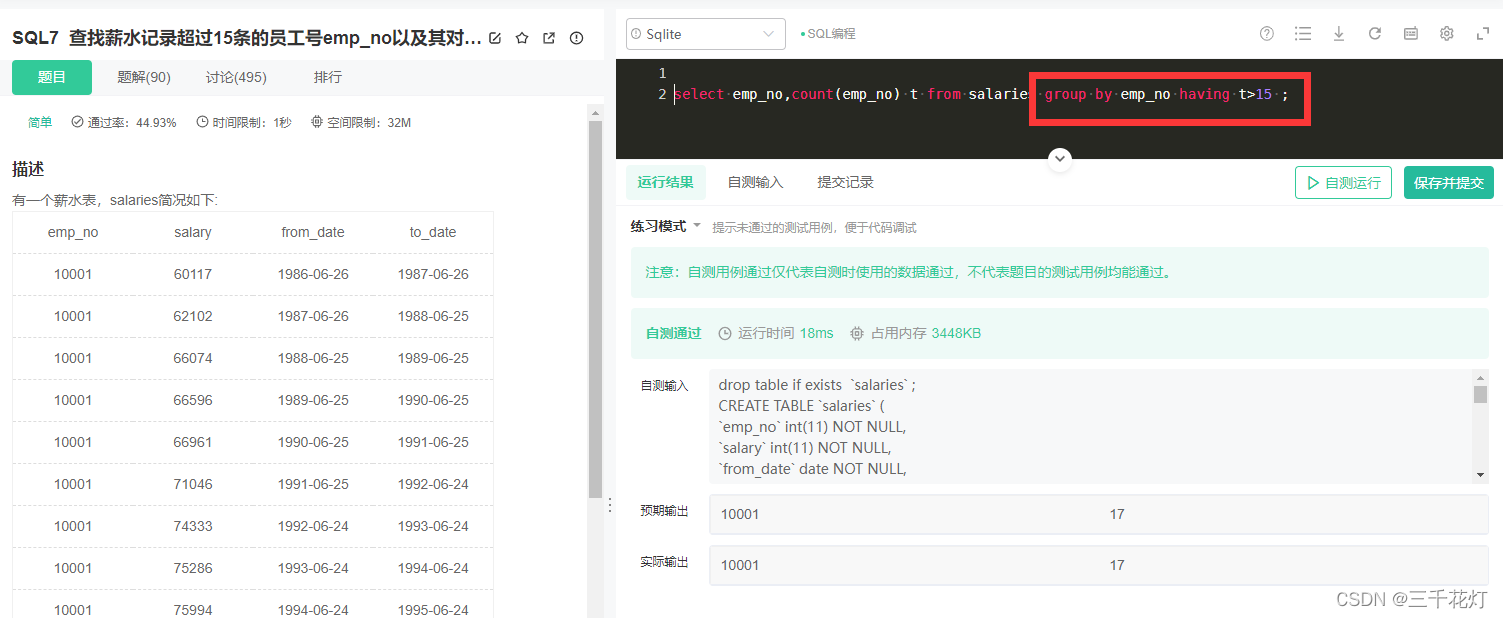sql语句中分组和排序(group by、order by、rank)
文章目录一、group by二、order by三、rank1.引入库2.读入数据一、group by提示:这里可以添加本文要记录的大概内容:例如:随着人工智能的不断发展,机器学习这门技术也越来越重要,很多人都开启了学习机器学习,本文就介绍了机器学习的基础内容。提示:以下是本篇文章正文内容,下面案例可供参考二、order by示例:pandas 是基于NumPy 的一种工具,该工具是为了解决数据分
一、group by
1、语法
group by ...
group by .... having ...
where ... group by ...
where ... group by ... having ...
where ... group by ... order by ...
2、示例
-
查询目前班级名称(group by)
select distinct class from student
select class from student GROUP BY class
(注释:dixtinct 去重) -
查询目前每个班级的人数(group by)
select class,count(sname) from student GROUP BY class -
查找薪水记录超过15条的员工号emp_no以及其对应的记录次数t(group by … having)
select emp_no,count(emp_no) t from salaries group by emp_no having t>15 ;

-
查询出1975年以后出生 男神和女神的人数(where … group by)
select sex ,count(sname) from student where birthday >=‘1975-01-01’ GROUP BY sex -
查询哪一个课程分数良好(>=85)人数大于2的课程编号(where … group by …having)
select cno ,count(degree) from score where degree>=85 GROUP BY cno having count(degree)>=2 -
查询出1975年以后出生 男神和女神的人数并按人数降序排序(where … group by … order by)
select sex ,count(sname) as s from student where birthday >=‘1975-01-01’ GROUP BY sex order by s desc
二、order by
1、语法
order by ... asc ----升序
order by ... desc ----降序
2、示例
select * from student order by age asc
select * from student order by age desc
--按工资薪酬降序排序
select emp_no,salary from salaries
order by salary desc

三、rank
1.概念
1、RANK()
在计算排序时,若存在相同位次,会跳过之后的位次。
例如,有3条排在第1位时,排序为:1,1,1,4······
2、DENSE_RANK()
这就是题目中所用到的函数,在计算排序时,若存在相同位次,不会跳过之后的位次。
例如,有3条排在第1位时,排序为:1,1,1,2······
3、ROW_NUMBER()
这个函数赋予唯一的连续位次。
例如,有3条排在第1位时,排序为:1,2,3,4······
2.示例
代码如下(示例):
select emp_no,salary,
dense_rank() over (order by salary desc) as t_rank
from salaries
order by salary desc,emp_no asc

更多推荐
 已为社区贡献7条内容
已为社区贡献7条内容









所有评论(0)